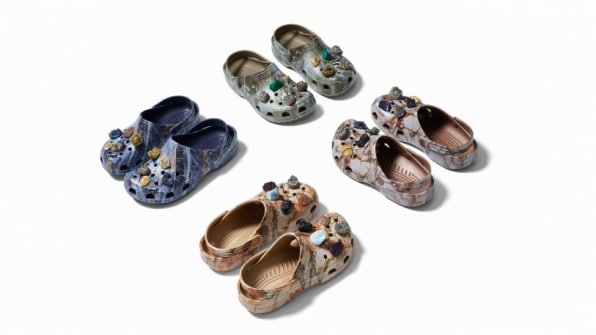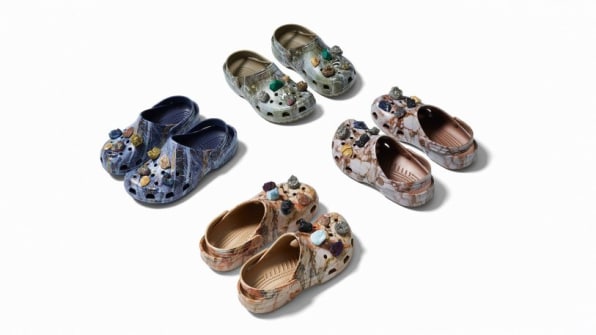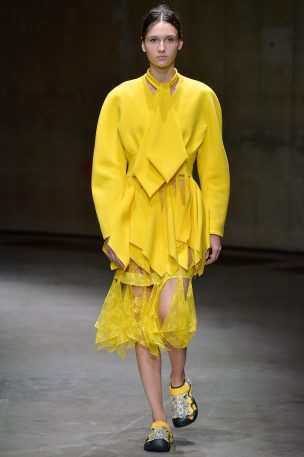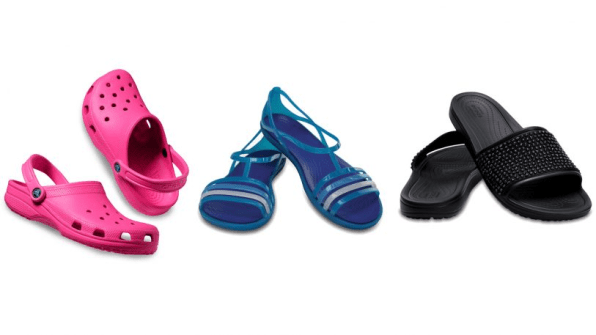
02 Oct The Cult Of Crocs: Can The Brand Make A Comeback By Fighting Its Haters?
There are only two types of people in the world: Crocs lovers and Crocs haters.
Every so often, these two camps collide and the results can be explosive. Two weeks ago, award-winning British designer Christopher Kane, a noted Crocs admirer, sent models down the runway for London Fashion Week in Crocs embellished with rhinestones. A few weeks before that, he dropped a limited-edition collection of Crocs clogs featuring tiger prints, colorful flower charms, and pom-poms that retailed on the brand’s website for $59.99, nearly double the price of a standard clog.
When asked to defend his aesthetic choices (several fashion bloggers simply asked, “seriously WTF?”), Kane explains, “I love that they are slightly awkward and might be perceived by some as ugly. They have a very naïve and childlike shape, which I especially like when they look extra clunky on the foot.”

Kane’s entire collaboration with the beloved/reviled footwear company has struck the fashion world as some sort of elaborate joke. Haters around the globe began to come out of the woodwork. Glamour said Crocs had filled “this decade’s quota for high-fashion high-fugly footwear.” The Brisbane Times described Crocs, point-blank, as “the ugliest shoes of all time.” A columnist in the Independent beseeched, “Stop trying to make Crocs happen.”
Back at Crocs HQ in Colorado, executives have quietly watched this back and forth unfold. But it is nothing new. The brand is used to being bullied. “We are the brand that people love to hate,” admits Michelle Poole, Croc’s head of global merchandising. “Actually, we value the tension because it keeps us relevant.” She points out that the Christopher Kane collaboration generated 3 billion global media impressions–and much of this was negative press.

The fact is, Crocs shaming works. While some Crocs customers are unapologetic about their love for the synthetic shoe—like Helen Mirren and Whoopi Goldberg—others are more conscious about how they might be perceived.
Take my editor, Anjali Khosla, who has worn Crocs for years. She favors the brand’s understated, feminine designs, like strappy jelly sandals in pastels or gray, that bear no resemblance to the orange clogs that Mario Batali wears. Her appreciation for the brand is so deep that she even convinced her fashion-forward mom—who owns multiple Gucci bags—to give the shoes a try, and now mother and daughter are Crocs wearers for life.
Khosla tells me there’s a secret sisterhood of Crocs-wearing women. It’s clear that Crocs has millions of fans out there, but it’s also true that many are embarrassed about wearing the shoe. “Sometimes you’re walking down the streets of New York and you spot another woman wearing a trendy pair of plastic sandals that most people would not even know are Crocs,” Khosla says. “For a split second, your eyes meet and you smile in acknowledgement.”
Crocs never set out to be a beautiful shoe. When the company launched in 2002 as a new take on the boat shoe, the aesthetic was immediately mocked, but fans loved how comfortable they were. The original clogs are made from a synthetic foam material that is remarkably springy and lightweight, which is why it has been widely embraced by people who are on their feet all day, like cooks, nurses, and doctors. The material has anti-bacterial properties, plus aerating holes all over the toe box, which prevents them from getting gross and grungy when you sweat. The oversized shape is perfect for toddlers whose feet are still growing. “For quite a lot of children, it is the very first shoe they ever put on by themselves,” Poole says.

For about a decade, Crocs built a loyal army of fans around the world. In 2006, it went public in the largest footwear IPO ever. Eventually, the brand diversified, creating trendy sandals, flats, and heels that bear little resemblance to the original clog, and now 50% of sales come from these non-clog styles.
“We want a wide range of consumers to be able to enjoy our brand,” Poole says. “But the architecture of the product stays the same. No matter what the style, we’re focused on comfort, practicality, and affordability.”
For six consecutive years, Crocs has generated $1 billion in sales, selling 50 million pairs of shoes annually. But the brand has fallen into a slump with revenues spiraling downward. In its most recent fourth quarter, it had a $44.5 million decline in sales, and total revenue for the quarter was $187.4 million, a 10% drop over the same period in 2015.
Part of this decline has been due to the overall decrease in foot traffic in malls, so the brand has announced it will close the 160 least performing of its 500 stores. But there’s also a sense that the brand might be losing some of its mojo—or that Crocs detractors may be successfully shaming Crocs customers out of buying the shoes.
Until now, the brand has chosen not to to take their critics on directly. “We’ve embraced the lovers,” Poole says. “What we haven’t done is fight the haters.”
But this might be changing. In April,Crocs decided to get into the fray and fight back with a new motto: “Come As You Are.” The new slogan publicly acknowledges the people who shame Crocs wearers. In one fell swoop, the phrase empathizes with Crocs customers while framing Crocs haters as judgmental and intolerant.
When the new motto launched, Crocs put out a video ad campaign on social media featuring Drew Barrymore talking about “coming together by celebrating our differences.”
In another video, Cena talks about being bullied as a child and invites a stream of everyday people to share their stories about being picked on because of their race or physical attributes. This language contains political undercurrents. It echoes Hillary Clinton’s “Better Together” election slogan and anti-racism campaigns. “I think its tapping into a zeitgeist out there right now,” Poole says. “We’re sending a message of inclusion.”
The question is, will this new branding be able to change the narrative about Crocs? Will Crocs succeed in empowering customers to wear the shoes proudly, as a marker of individuality and uniqueness? New data appears to show that the company is on the right track—particularly with younger consumers. During the back-to-school season, Crocs stores saw a 12% increase in foot traffic, which was the biggest spike among national retailers, according to a survey of 50 million customers conducted by inMarket.
From the brand’s perspective, it is particularly important to nurture Crocs’ youngest consumer and ensure that these impressionable Crocs wearers do not feel peer pressure to give up their clogs as they start making their own sartorial choices.
“The very first generation of kids who wore the product as babies are now young adults,” she says. “These kids have worn Crocs all their life. There is a nostalgia about them.”
With its new approach, Crocs is moving away from treating the shoe as just pragmatic footwear to an object with more profound meaning. “Crocs is sending a message about culture,” Poole says. “Our vision is for everybody to be comfortable in their own shoes.”
And she means that literally.
Source: Fast Company




Sorry, the comment form is closed at this time.